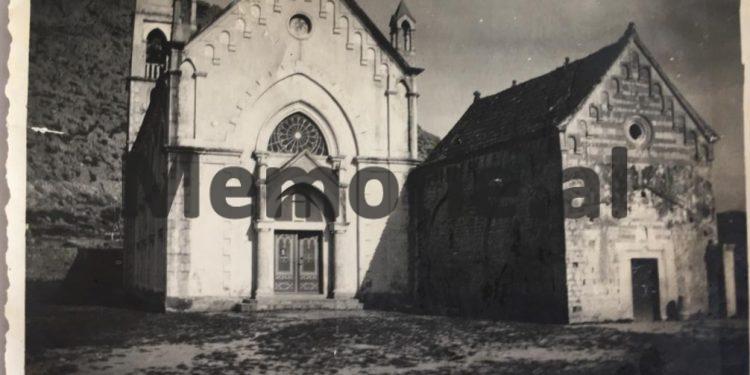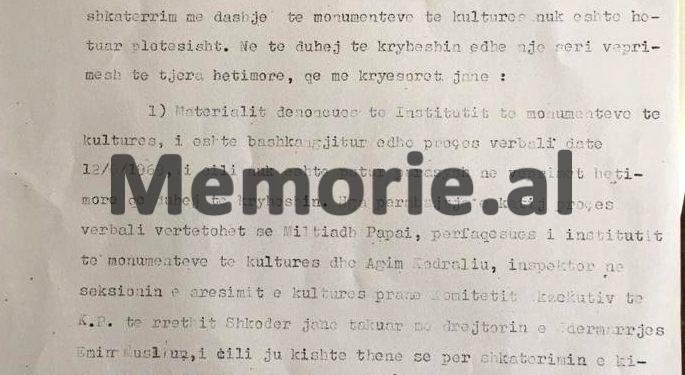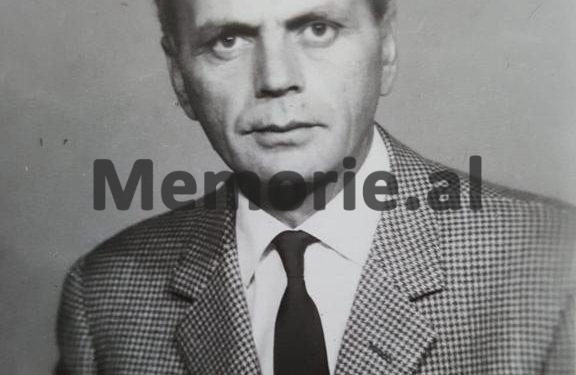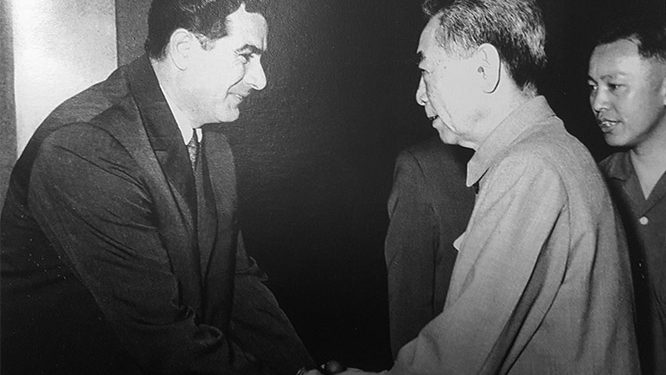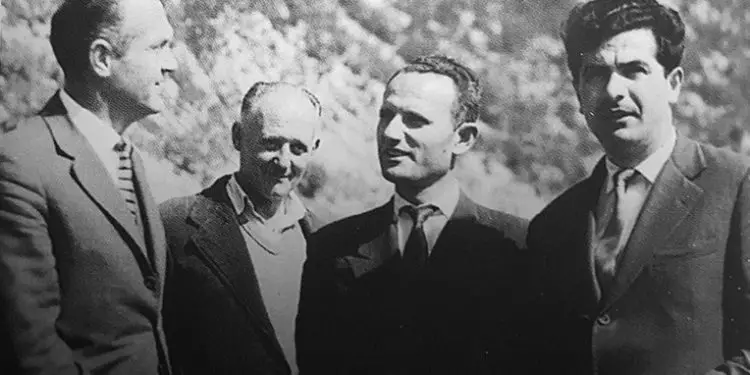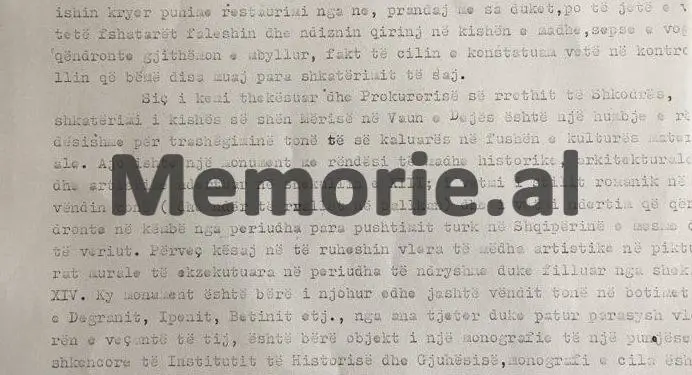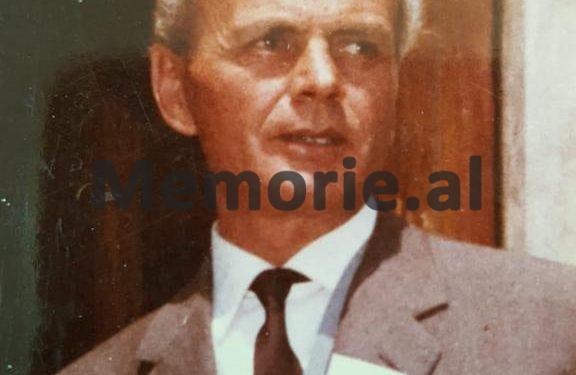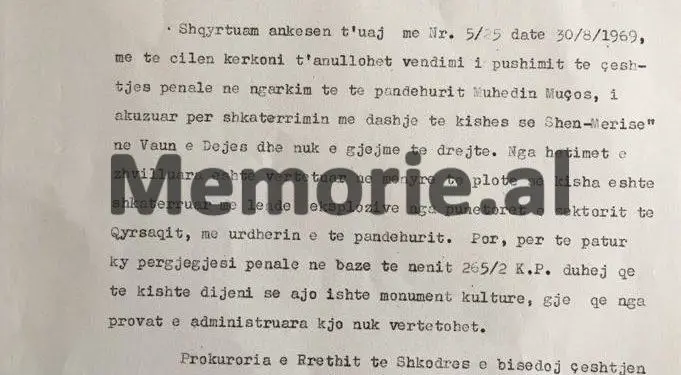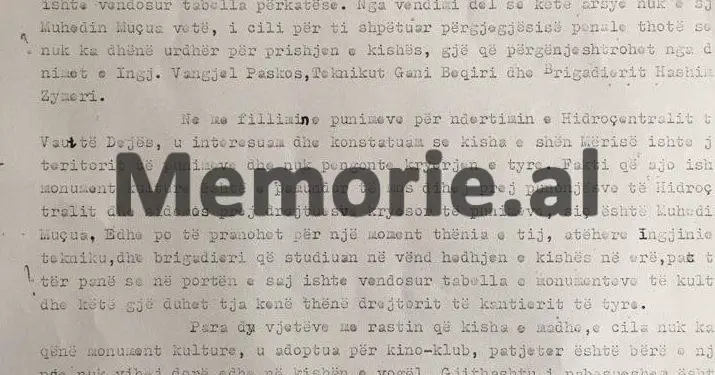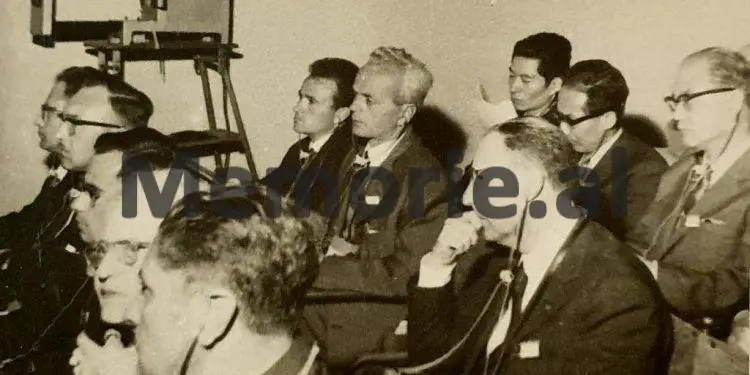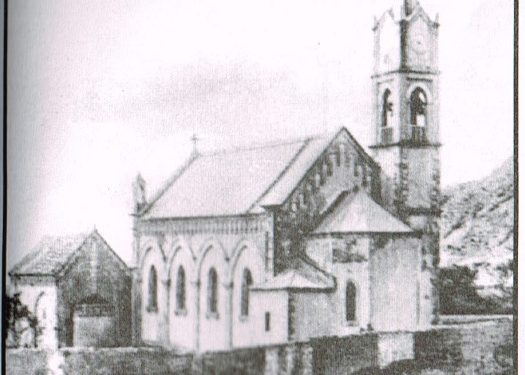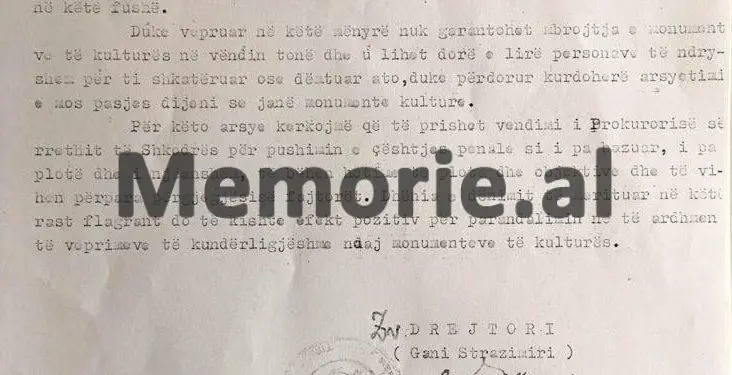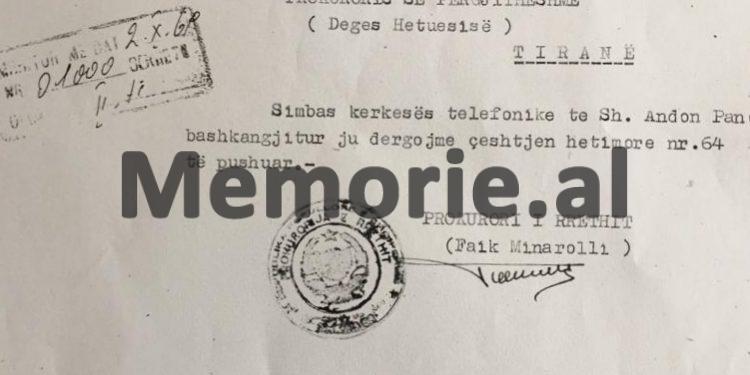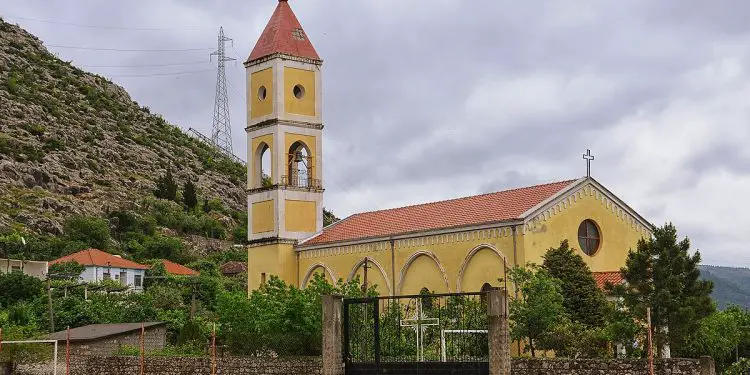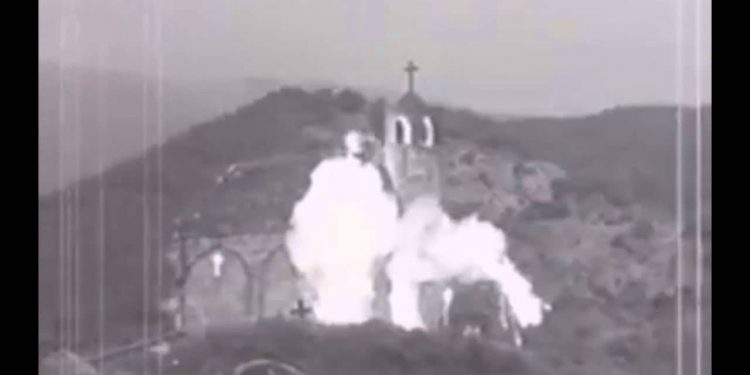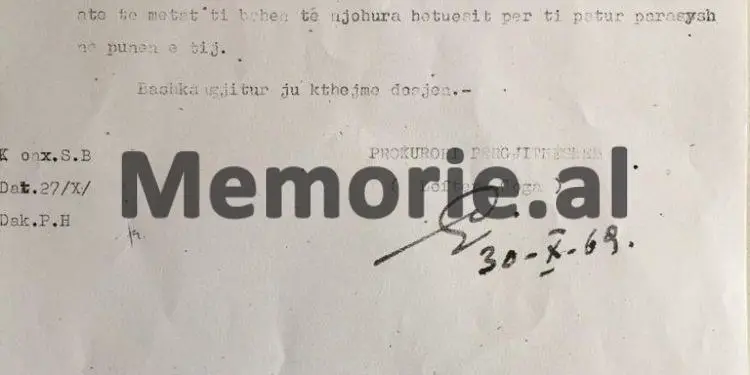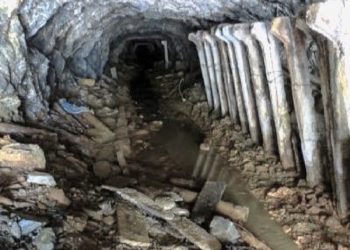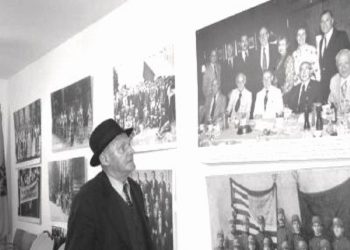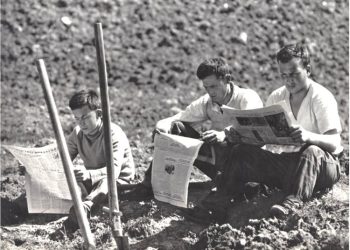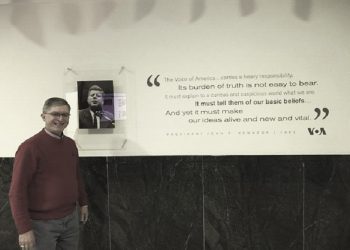Dashnor Kaloçi
Memorie.al publishes the unknown history of the demolition and destruction of the Church of St. Mary in Vaun e Dejës in early June 1969, which was a cult object of rare value for the Albanian cultural heritage, since it was built in the XIII century -to be considered one of the only Roman-style constructions, still standing since the period before the Turkish occupation, which made it unique, not only in Albania but also in the Balkans as such, was introduced and included in European catalogs and cultural heritage journals. How the director and at the same time the founder and legend of the Institute of Cultural Monuments, the famous architect Gani Strazimiri (graduated in Italy and the Soviet Union) reacted, denouncing to the Shkodra Prosecutor’s Office and the General Prosecutor’s Office, all the perpetrators of that vandal act, such as the director of the construction site, Muhedin Muço, the brigadier, Hashim Zyberi (“Hero of Socialist Labor”), the director of the State Construction Company of the Hydropower Plant, Emin Musliu, etc., considering them as the main culprits and demanding the release of before the trial for the crime they had committed, as well as the dismissal of the criminal case a few months later by the Prosecution, which concluded that: “the director of the construction site did not know that the church was a cultural monument, as he had not seen it. the sign on her door, where it was said that she was protected by the state ”?!
Although more than half a century has passed since the demolition and demolition of the Church of St. Mary in Vaun e Dejës, which was built in the 13th century and was the only object of worship held by those belonging to the period of before the Turkish occupation, even being considered as one of the objects of cultural heritage with rare and unique values not only in Albania but also in the Balkans, still continues to this day to be discussed and discussed, not only for its great importance. that it had that object that was protected by the state as a Cultural Monument, but also for the way they destroyed it and who were those who ordered its destruction ?! Since the beginning of June 1969, when that rare object of Albanian cultural heritage, which was included in the catalogs and various European magazines, came out, the “black smoke” has circulated and still continues to spread various legends and testimonies. , never “reconciling” in a concrete name, as for the real author of its destruction and those who hid behind it… ?! This event, which has been rightly considered by many cultural heritage personalities, various scholars, etc., as one of the biggest vandalisms of the communist regime of Enver Hoxha, in the “great action for the fight against religious beliefs” that led to the destruction of dozens of cult objects of great cultural value. Regarding this unique event, from the day when the news was just learned, or more precisely “the way”, that it no longer existed, the director and at the same time the founder of the Institute of Cultural Monuments in Tirana, the famous architect, Gani Strazimiri, ( educated and graduated in Italy and the Soviet Union), otherwise known as the “legend of cultural monuments”, made the denunciation to the prosecution and sued the state. And after a long ordeal of his, knocking on the highest offices of the communist state of that time, where he made denunciations with concrete names for the perpetrators of that masquerade, as well as with letters, telegrams, reports, information, etc., etc. that case was closed by the General Prosecutor’s Office, with the banalest possible argument that: “the director of the construction site who ordered the destruction of that church did not know that it was a cultural monument, as he did not see the sign that was at its door.” ?!
In connection with this event and the whole history of the destruction of that cult object that has already remained only in the memory of those people who have had the opportunity to see it up close, or in some film images and rare photos, we know some archival documents that Memorie.al has provided them from the fund of the former Central Committee of the ALP, which clearly and accurately proves the true “face” of that regime, which, although it took the decision to demolish that church, did not have the courage to God forbid that action, but he hid behind some workers and leaders of a construction site who were working on the construction of the Vau i Dejës Hydropower Plant, saying that: “they demolished it with initiative in the framework of the fight against religious ideology” ?!
follows from the previous number
Gani Strazimir’s complaint to the General Prosecutor’s Office, for the dismissal of the criminal case by the Shkodra Prosecutor’s Office
PEOPLE’S REPUBLIC OF ALBANIA
INSTITUTE OF CULTURAL MONUMENTS
Nr. 5/25 Prot. Tirana on 30/8/1969
GENERAL PROSECUTOR’S OFFICE
T I R A N Ë
The managers of the construction works of the Vau i Dejës Hydropower Plant. We add that that church has not been used for religious rites for decades and restoration work has been done on it by us, so apparently, if it is true that the villagers prayed and lit candles in the big church because the little one always stayed closed, a fact which we found ourselves in the control we made a few months before its destruction.
As we have pointed out to the Shkodra District Prosecutor’s Office, the destruction of the church of St. Mary in Vaun e Dejës is a great loss for our heritage of the past in the field of material culture. It was a monument of great historical, architectural and artistic importance, built in the 13th century: the only Roman-style building in our country (and one of the few in the Balkans), and the only standing building from the period of before the Turkish occupation of Central and Northern Albania. In addition, great artistic values were preserved in the murals executed in different periods, starting from the 14th century. This monument has also become known outside our country in the publications of Degrand, Ipen, Betin, etc., on the other hand, given its special value, it has become the object of a monograph of a scientific employee of the Institute of History and Linguistics, a monograph which was published in the bulletin of historical sciences No. 3 of 1964, together with the summary in foreign languages, as well as in Studica Albanica No. 2, 1964. For these reasons, the destruction of this important monument is not only a great loss for the legacy of the past in the field of material culture, but it is also detrimental to them from a political point of view.
The destruction of the church of St. Mary in Vaun e Dejës is the sixth case of the destruction of monuments in the district of Shkodra. A few years ago, two important monuments were blown up, the bezisten and the hamam on the shore of Buna, the monument of culture owned by Musa Duli, etc. is damaged. The destruction of the bezisten and the hammam was premeditated at night in order to bring them to justice. We have also denounced these cases to the Shkodra District Prosecutor’s Office, but the cases were dismissed so that the destruction of cultural monuments in this district is indirectly allowed.
On this occasion, we consider it necessary to bring to your attention the Prosecutions of some other districts, such as Berat, Lezha, etc. Our denunciations regarding the destruction of cultural monuments have not been met, there has been a reluctance to implement the laws in this regard and there is some agreement with illegal actions, even by state or government bodies when it comes to legal violations in this area…
By doing so, the protection of cultural monuments in our country is not guaranteed and various persons are left free to destroy or damage them, always using the reasons for not knowing that they are cultural monuments.
For these reasons, we demand that the decision of the Shkodra District Prosecutor’s Office to dismiss the criminal case as unfounded, incomplete, and biased, to conduct a full and objective investigation and bring the perpetrators to justice, be overturned. Giving the deserved punishment in this flagrant case would have a positive effect on the future prevention of illegal actions against cultural monuments.
D I R E C T O R
Gani Strazimiri
Letter from the General Prosecutor’s Office to the Shkodra Prosecutor’s Office, warning them not to fully investigate the incident
PEOPLE’S REPUBLIC OF ALBANIA
GENERAL PROCUREMENT
Tirana Investigation Directorate, on 30 / X / 1969
Nr. 626 / III
GROUP PROSECUTOR’S OFFICE
(Investigation Sector)
SH K O D Ë R
The criminal case against defendant Muhedin Muço, accused of intentional destruction of cultural monuments, has not been fully investigated. In them, a series of other investigative actions had to be carried out, the most important of which are:
The report of the Institute of Cultural Monuments was attached to the reporting material dated 12/6/1969, which was not taken into account in the investigative actions that had to be carried out. From the content of this minutes, it is confirmed that Miltiadh Papai, representative of Cultural Monuments and Agim Kodraliu, inspector in the Education and Culture section at the Executive Committee of the People’s Council of Shkodra district, met with the director of the Enterprise, Emin Musliu, who he had told you that he was aware of the destruction of the church of Vau i Dejës and that he considered this action quite normal. The question of the quality of the witness of Miltiadh Papa and Agim Kodraliu was more than necessary because they could pave the way for the investigation in terms of the development of the subject.
The secretary of the Party Committee for Vaun e Dejës and the director of the Enterprise should also have been asked about the fact that they had reviewed the workers’ lightning sheet, what they had placed and whether they had given them a written answer, in case the lightning sheet they had given him the answer, this should have been sought.
Witness Xhemal Borova, a member of the Professional Committee of the Enterprise, tells that when he met with Kasëm Koçi, he told him that the Party Committee responded with a lightning bolt, which I had to dismantle. Kasëm Koçiu should have been asked to give explanations about this fact, if he had seen the answer himself, or had heard it from others. Likewise, Hashim Zyberi should have been asked to clarify who had heard that the lightning response had come out.
Witness Vangjo Pasho, a civil engineer who took part in the mining of the church, said: “I believe that the directorate has given its approval for this demolition, as long as the air compressor, the explosive, etc. have gone there.” The witness should have been asked to explain how the air compressor and other materials were moving so that evidence could be administered through them to uncover the subject of the crime.
A confrontation had to take place between the defendant Muhedin Muço and the witness Hashim Zyberi, whether it was true that the defendant had ordered this to destroy the church, or whether the witness had asked him for help.
Some of the witnesses questioned did not know that the church was a cultural monument but acknowledged that something had been written in Italian on its door. The questioning of witnesses Matish Paloka and Pjetër Zefnikaj, or other witnesses who live near the church, if there was an inscription on the door of the church in Italian or any other language, was more than necessary.
So the above flaws show that the investigation has not been complete and careful. We did not annul the dismissal decision because the issue has passed the actuality, but despite the shortcomings, it should be made known to the investigator in order to take into account his work.
Attached we return the file.
GENERAL PROSECUTOR’S OFFICE
(Lefter Goga)
30-X- 1969
The Response of the General Prosecutor’s Office to the Institute of Monuments, where it announces the termination of the criminal case
PEOPLE’S REPUBLIC OF ALBANIA
GENERAL PROSECUTOR’S OFFICE
Tirana Investigation Directorate, on 5 / XI / 1969
Nr. 626 / III
INSTITUTE OF CULTURAL MONUMENTS
T I R A N Ë
We reviewed your complaint with No. 5/25 dated 30/8/1969, requesting that the decision to dismiss the criminal case against the defendant Muhedin Muço be dropped, accused of intentional destruction of the church of St. Mary in Vaun e Dejës and we do not find it right. From the investigations carried out, it has been fully established that the church was destroyed with explosives by the workers of the Qyrsaq sector, by order of the defendant. But, in order to have this criminal responsibility based on article 295/2 K.P. she should have known that it was a cultural monument, which is not proven by the evidence administered to us.
The Shkodra District Prosecutor’s Office is also discussing the matter with the Party Committee to take all measures so that actions of this nature are not repeated in the future.
GENERAL PROSECUTOR’S OFFICE
(Lefter Goga)
05/11/1969
Memorie.al




